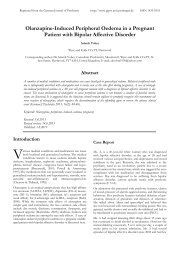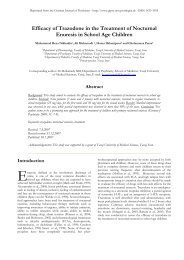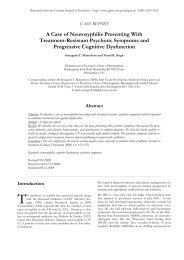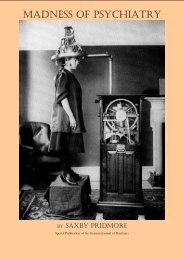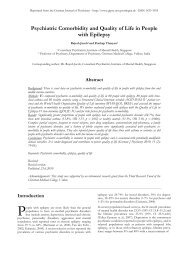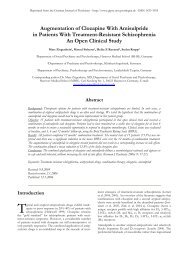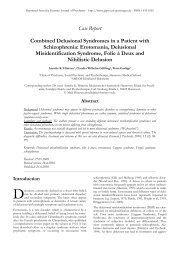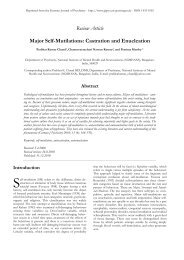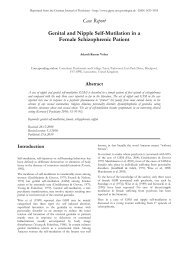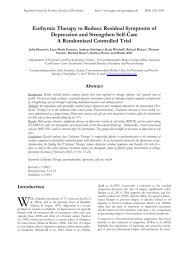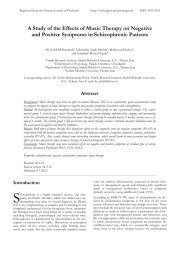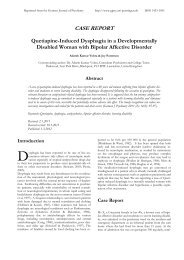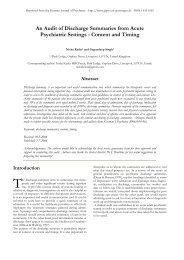Presentation of Catatonia in Mood Disorder vs. Schizophrenia
Presentation of Catatonia in Mood Disorder vs. Schizophrenia
Presentation of Catatonia in Mood Disorder vs. Schizophrenia
You also want an ePaper? Increase the reach of your titles
YUMPU automatically turns print PDFs into web optimized ePapers that Google loves.
Repr<strong>in</strong>ted from the German Journal <strong>of</strong> Psychiatry · http://www.gjpsy.uni-goett<strong>in</strong>gen.de · ISSN 1433-1055<br />
Letter to the Editor<br />
<strong>Presentation</strong> <strong>of</strong> <strong>Catatonia</strong> <strong>in</strong> <strong>Mood</strong> <strong>Disorder</strong> <strong>vs</strong>.<br />
<strong>Schizophrenia</strong><br />
Arv<strong>in</strong>d Kendurkar<br />
Department <strong>of</strong> Psychiatry, Pt. J. N. M. Medical College, Raipur (C.G.), India<br />
Correspond<strong>in</strong>g author: Arv<strong>in</strong>d Kendurkar, Assistant Pr<strong>of</strong>essor, Consultant <strong>in</strong> Adult Psychiatry, Department <strong>of</strong><br />
Psychiatry, Pt. J. N. M. Medical College Raipur (Chhattisgarh)-492006, India; E-mail: akendurkar@gmail.com<br />
Keywords: catatonia, schizophrenia, mood disorder<br />
Received: 24.11.08<br />
Published: 15.1.2008<br />
German J Psychiatry 2008;11: 32-33<br />
C<br />
atatonia, a syndrome <strong>of</strong> motor deregulation, is a wellrecognized<br />
entity present<strong>in</strong>g <strong>in</strong> nearly 7% to 15% <strong>of</strong><br />
acute psychiatric <strong>in</strong>patients (F<strong>in</strong>k and Taylor, 2006).<br />
It is known to occur <strong>in</strong> various disorders with mood, psychotic<br />
and medical disorders be<strong>in</strong>g the most common causes<br />
(Takata et al., 2005; F<strong>in</strong>k and Taylor, 2003). Nearly 30 presentations<br />
have been described <strong>in</strong> catatonia (Bush et al.,<br />
1996a; F<strong>in</strong>k and Taylor, 2003) although the presentations<br />
across the various diagnoses are not clear. This report presents<br />
the symptomatology <strong>of</strong> <strong>Catatonia</strong> between <strong>Mood</strong> <strong>Disorder</strong><br />
and <strong>Schizophrenia</strong>.<br />
Consecutive patients attend<strong>in</strong>g adult psychiatry outpatient<br />
cl<strong>in</strong>ic were screened on Stony Brook <strong>Catatonia</strong> Screen<strong>in</strong>g<br />
Instrument (Bush et al., 1996b). Screen positive subjects<br />
diagnosed as <strong>Mood</strong> <strong>Disorder</strong> (either major depression or<br />
bipolar disorders) and <strong>Schizophrenia</strong> on Structured Cl<strong>in</strong>ical<br />
Interview for DSM-IV Axis-I disorder (First et at., 2002)<br />
were assessed for the phenomenology <strong>of</strong> catatonic symptoms<br />
on Stony Brook <strong>Catatonia</strong> Rat<strong>in</strong>g Scale (BFCRS) (Bush<br />
et al., 1996b). After screen<strong>in</strong>g 511 patients (52 <strong>of</strong> <strong>Schizophrenia</strong><br />
and 459 <strong>of</strong> <strong>Mood</strong> <strong>Disorder</strong>), five schizophrenic<br />
patients with catatonia and six mood disorder patients with<br />
catatonia were obta<strong>in</strong>ed. On comparison, both types <strong>of</strong><br />
catatonic patients did not differ <strong>in</strong> terms <strong>of</strong> age, gender and<br />
total duration <strong>of</strong> illness. The retarded symptoms <strong>of</strong> catatonia<br />
(withdrawal, stupor, mutism, postur<strong>in</strong>g and negativism) were<br />
the most commonly observed catatonic features <strong>in</strong> both the<br />
categories. However, the excited features (excitement and<br />
echolalia/echopraxia) were observed only <strong>in</strong> patients with<br />
mood disorder. Independent samples t-test did not reveal<br />
any difference <strong>in</strong> mean score <strong>of</strong> total items and number <strong>of</strong><br />
items <strong>of</strong> BFCRS. Mult<strong>in</strong>omial Regression analysis did not<br />
reveal association <strong>of</strong> any particular catatonic symptom with<br />
mood disorder or <strong>Schizophrenia</strong>. The small sample size had<br />
limited the statistical outcome <strong>of</strong> this study that can be overcome<br />
by study<strong>in</strong>g a larger sample.<br />
To recapitulate, the phenomenology and demography <strong>of</strong><br />
catatonia does not vary between the two diagnoses. Therefore,<br />
tak<strong>in</strong>g our limitations, it may be proposed that catatonia<br />
has an <strong>in</strong>dependent psychopathology, which is unrelated<br />
to the underly<strong>in</strong>g psychiatric diagnosis. This f<strong>in</strong>d<strong>in</strong>g justifies<br />
the argument <strong>of</strong> researchers for provid<strong>in</strong>g <strong>Catatonia</strong> an <strong>in</strong>dependent<br />
syndromal category <strong>in</strong> future editions <strong>of</strong> Psychiatric<br />
classifications (F<strong>in</strong>k and Taylor, 2006).<br />
References<br />
Bush G, F<strong>in</strong>k M, Petrides G, Dowl<strong>in</strong>g F, Francis A: <strong>Catatonia</strong>,<br />
I: rat<strong>in</strong>g scale and standardized exam<strong>in</strong>ation. Acta<br />
Psychiatr Scand 1996a; 93:129–136.<br />
Bush G, F<strong>in</strong>k M, Petrides G, Dowl<strong>in</strong>g F, Francis A: <strong>Catatonia</strong>,<br />
II: treatment with lorazepam and electroconvulsive<br />
therapy. Acta Psychiatr Scand 1996b; 93:137–<br />
143.<br />
F<strong>in</strong>k M, Taylor MA: <strong>Catatonia</strong>: subtype <strong>of</strong> syndrome DSM<br />
(editorial). Am J Psychiatry 2006; 163:1875–1876.<br />
F<strong>in</strong>k M. and Taylor M.A. (2003). <strong>Catatonia</strong>: A Cl<strong>in</strong>ician's<br />
Guide to Diagnosis and Treatment. New York:<br />
Cambridge University Press, 147-169.<br />
First MB, Spitzer RL, Gibbon M, et al. Structured Cl<strong>in</strong>ical<br />
Interview for DSM-IV-TR Axis I <strong>Disorder</strong>s, Research<br />
Version, Patient Edition. (SCID-I/P). New
York (NY): New York State Psychiatric Institute;<br />
2002.<br />
Takata T., Takaoka K. and Fujigaki M. (2005) <strong>Catatonia</strong> <strong>in</strong><br />
the elderly: a review. Int J Psychiatry Cl<strong>in</strong> Prac, 9(4),<br />
230-237.<br />
The German Journal <strong>of</strong> Psychiatry · ISSN 1433-1055 · http:/www. gjpsy.uni-goett<strong>in</strong>gen.de<br />
Dept. <strong>of</strong> Psychiatry, The University <strong>of</strong> Gött<strong>in</strong>gen, von-Siebold-Str. 5, D-37075 Germany; tel. ++49-551-396607; fax:<br />
++49-551-392004; e-mail: gjpsy@gwdg.de<br />
33



